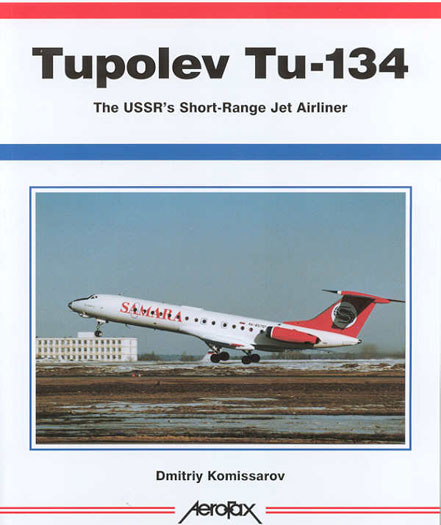Tupolev
Tu-134
The USSR’s Short-Range
Jet Airliner

by Dmitriy Komissarov
Aerofax
S u m m a r y
|
| Title: |
Tupolev
Tu-134 – The USSR’s Short-Range Jet Airliner
by Dmitriy Komissarov. Aerofax Series
Published by Midland Publishing |
| ISBN: |
1857801598 |
| Media and Contents: |
Soft cover; 184 pages plus covers |
| Price: |
GBP£19.99 online from Ian Allen Publishing |
| Review Type: |
First Read |
| Advantages: |
Thorough coverage of this important
Soviet airliner |
| Disadvantages: |
|
| Recommendation: |
Recommended for Russian Aviation
Enthusiasts |
Reviewed by Ken Bowes

HyperScale is proudly supported by Squadron
This Aerofax title “Tupolev Tu-134” is probably of
much narrower interest than most, particularly to Western readers.
That aside author Dmitriy Komissarov has put in a
sterling effort documenting this aircraft in its many civil and military
guises. The design of the Tu-134 dates back to the 1950s when the USSR
looked to enter the age of jet transport. With the Tu-124 (an airliner
variant of the Tu-16) under its belt and impetus given to the program by
Premier Nikita Khruschev’s flight in a French Caravelle, the Tupolev
Bureau embarked on a design for a similar short haul airliner in 1960.
This aircraft became the Tu-134. In this book Komissarov details the
complicated design process with the many hurdles that needed to be
crossed before production began in earnest. He then proceeds to cover
the many variants and production processes, laying the foundation for
later chapters dealing with the specific civil and military use of the
major sub-types. The Tu-134 was not without experimental developments
and these too are dealt by the author. One of the more interesting
developments was the T-134UBL which was used as a crew trainer for
Tu-22M Backfire and later Tu-160 Blackjack crews to preserve the life of
the actual bombers. The Backfire nose grafted on this variant is
unmistakable.
The author has chosen to break
the book into themed chapters rather than a chronological approach. This
is in common with most volumes from this series. Hence the reader
progresses through chapters on versions and variants, unrealised
projects, service life, CIS operators of the Tu-134, foreign operators
and finally a technical analysis of the airframe itself. These chapters
provide a short description of each subtype, supported by many black and
white and colour photographs. Each chapter is well illustrated, with
many drawings, artists’ concepts and photographs supporting the detailed
text. It was pleasing to note a higher than average number of colour
photos in this volume, probably due to the adage that the key attraction
of airliners is their colourful livery.
This book will appeal to those with an interest in Russian aviation. One
particular highlight is the many general arrangement drawings of the
major sub-types that are included. These are a handy way to identify the
many non-standard aircraft modified for military or trials use. Hard
core facts and figures fans will get their teeth into the performance
statistics and the comprehensive production list, which attempts to
document the service lives of each airframe by construction number. Also
included is a detailed appendix on attrition of the type, with detailed
discussion and photographs covering the accidents involving this
aircraft. Overall a very interesting read on a somewhat out of the
ordinary (for me) subject.
The book consists of 184 pages printed on glossy paper between cardboard
covers.
Recommended.
Thanks to Simon of DLS Australia for the review
sample
Review Copyright © 2004 by
Ken Bowes
This Page Created on 07 October, 2004
Last updated 08 October, 2004
Back to HyperScale Main Page
Back to Reviews Page
|
Home | What's
New | Features
| Gallery |
Reviews | Reference
| Forum
| Search